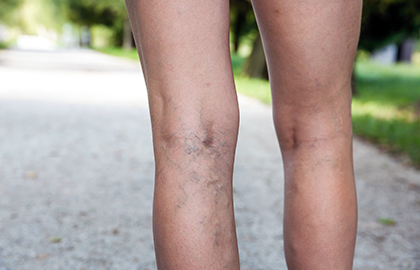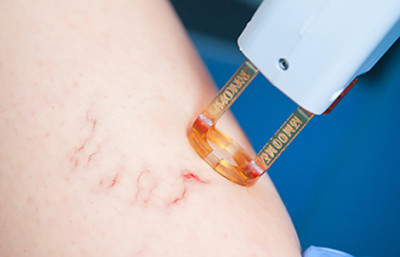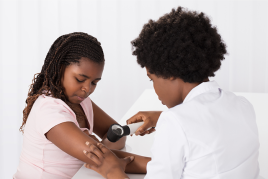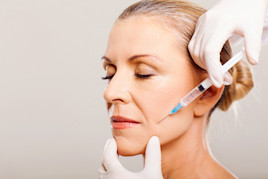Leg veins: Why they appear and how dermatologists treat them

Minimally invasive treatment can get rid of or fade leg veins. Treatment can also diminish symptoms like pain and fatigue and prevent complications.
Why we get visible leg veins
Varicose and spider veins are damaged veins. We develop them when tiny, one-way valves inside the veins weaken. In healthy veins, these valves push blood in one direction — back to our heart. When these valves weaken, some blood flows backward and accumulates in the vein. Extra blood in the vein puts pressure on the walls of the vein.
With continual pressure, the vein walls weaken and bulge. In time, we see a varicose or spider vein.
Some people have a higher risk of developing these veins. If blood relatives have them, you have a higher risk. Many people get them because they sit or stand for long periods most days of the week. These veins also become more common with age and during pregnancy.
Spider veins can also be caused by sunlight, hormonal changes, or an injury.
How dermatologists treat leg veins
Treatment options range from self-care to minor surgery. A dermatologist may use one or more of these treatments:
Self-care: Your dermatologist can give you tips to improve your circulation. These tips include:
Exercise
Elevate your legs
Sit for long periods? Get up and walk around every 30 minutes
Stand for long periods? Take a break every 30 minutes
Avoid soaking in hot baths for long periods of time
Self-care tips can help prevent new varicose and spider veins but cannot get rid of existing ones.
Compression stockings: These stockings apply steady pressure to help move the blood back to your heart. The steady pressure also lessens swelling in your lower legs and reduces the risk of getting a blood clot. You’ll still have visible leg veins, though.
If you need compression stockings, a dermatologist can examine you so that you get the proper size and right amount of pressure.
Sclerotherapy: This is the most common treatment for leg veins. Over the years, dermatologists have improved sclerotherapy to make it safer and give patients better results. Today, dermatologists use it to treat spider and small varicose veins.
If you have sclerotherapy, this is what happens during treatment:
Your dermatologist injects a chemical into the spider or varicose vein, which irritates the wall of the vein. Different areas of the vein are injected.
After the injections, your dermatologist may massage the area.
A compression stocking is then placed on each leg.
You will be observed for a time and then be able to go home.
To help prevent possible side effects, you will need to take daily walks and wear the compression stockings as directed. Most patients wear the compression stockings for 2 to 3 weeks.
You can return to work and most activities the next day.
Sclerotherapy causes the walls of the vein to stick together, so the blood cannot flow through it anymore. This improves circulation in the treated leg and reduces swelling.
Spider veins usually disappear in 3 to 6 weeks. Varicose veins take 3 to 4 months.
To get the best results, you may need 2 or 3 treatments. A dermatologist can perform these treatments during an office visit. No anesthesia is needed.
Laser treatments: Dermatologists use lasers to treat spider veins and small varicose veins. During laser treatment, your dermatologist directs the laser light at the vein.
Laser light can destroy the vein without damaging your skin.

Small spider veins may disappear immediately after treatment. Larger spider veins and varicose veins will darken, and you’ll likely see them for 1 to 3 months before they disappear. To get complete clearing, you may need 3 or more treatments.
Most patients can return to work and many of their normal activities the next day.
After each treatment, some patients need to wear compression stockings for a short time.
Every patient will need to protect the treated area from the sun for 3 to 4 weeks. This helps prevent dark spots from developing. Protecting your skin from the sun year round helps to prevent new spider veins and skin cancer.
Endovenous laser therapy (EVLT) and radiofrequency ablation (RFA): EVLT and RFA are newer treatments. They often replace the need to surgically remove a vein.
Both treatments work inside the vein to destroy it. Dermatologists use EVLT to treat spider veins and small varicose veins. RFA is used to treat large varicose veins.
This is what happens during these treatments:
You receive local anesthesia, which numbs the area to be treated. The anesthesia also causes the area to swell.
Your dermatologist then makes a small incision and inserts a laser fiber (for EVLT) or catheter (for RFA) into the vein.
Your dermatologist activates the laser or radiofrequency device, which heats up the vein, causing it to collapse and seal shut. The heat does not harm the surrounding area.
After treatment, a compression stocking will be placed on each leg.
You are observed for a time and then able to go home.
To help prevent possible side effects, you will need to take daily walks and wear the compression stockings as directed. Most patients wear the compression stockings for 1 to 2 weeks.
You can return to work and most activities the next day.
It takes about 1 year for the treated vein to disappear with both EVLT and RFA. To get best results, you may need more than one treatment.
Physical exam essential before treatment
A physical exam helps your dermatologist decide if leg vein treatment is safe for you. During the physical exam, your dermatologist will look closely at your leg veins and ask about your medical history.
Non-invasive tests that look at the veins in your legs may also be necessary. A Doppler ultrasound will show the blood flow in your leg veins. Plethysmography (pla-thiz-muh-graph-ē) uses a blood pressure cuff to measure changes in blood volume, which can help find problems like abnormal blood flow.
After reviewing all of the information, your dermatologist can tell you if leg vein treatment is right for you and which treatment would be most effective. Sometimes, more than one type of treatment will be recommended to give you the best results and reduce side effects.
If treatment is recommended, be sure to ask whether insurance will cover it. You’ll likely have to pay if treatment is performed only to improve the look of your legs.
Skill is the key to getting best results
The results you will see depend largely on the person performing the leg vein treatment. Because dermatologists made many of the advances that have given us safer, less invasive treatments for leg veins, they have a leg up on using these treatments.
You can find a dermatologist who treats leg veins by going to, Find a dermatologist and choosing the specialty of Cosmetic Dermatology.
When you call the office, ask if the dermatologist regularly treats leg veins.
Related AAD resources
Images
Images 2 and 3 from Thinkstock
References
Moul DK, Housman L, et al. “Endovenous laser ablation of the great and short saphenous veins with a 1320-nm neodymium: yttrium-aluminum-garnet laser:” J Am Acad Dermatol. 2014;70:326-31.
Nijsten T and van den Bos RR, et al. “Minimally invasive techniques in the treatment of saphenous varicose veins.” J Am Acad Dermatol. 2009;60:110-9.
Weiss RA and Dover JS. “Leg vein management: Sclerotherapy, ambulatory phlebectomy, and laser surgery.” In: Kaminer MS, Dover JS, et al. Atlas of Cosmetic Surgery (1st edition). WB Saunders Company, Philadelphia, 2002: 407-32.
Weiss RA and Weiss MA.“Treatment for varicose and telangiectatic leg veins.” In: Wolff K, Goldsmith LA, et al. Fitzpatrick’s Dermatology in General Medicine (seventh edition). McGraw Hill Medical, New York, 2008: 2349-56.
Yiannakopoulou E. “Safety concerns for sclerotherapy of telangiectases, reticular, and varicose veins. Pharmacology. 2016;98:62–9.
 Molluscum contagiosum: How to safely treat it
Molluscum contagiosum: How to safely treat it
 Biosimilars: 14 FAQs
Biosimilars: 14 FAQs
 Practice Safe Sun
Practice Safe Sun
 Relieve uncontrollably itchy skin
Relieve uncontrollably itchy skin
 Fade dark spots
Fade dark spots
 Untreatable razor bumps or acne?
Untreatable razor bumps or acne?
 Laser hair removal
Laser hair removal
 Scar treatment
Scar treatment
 Botox
Botox
 Free materials to help raise skin cancer awareness
Free materials to help raise skin cancer awareness
 Dermatologist-approved lesson plans, activities you can use
Dermatologist-approved lesson plans, activities you can use
 Find a Dermatologist
Find a Dermatologist
 What is a dermatologist?
What is a dermatologist?